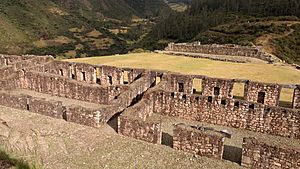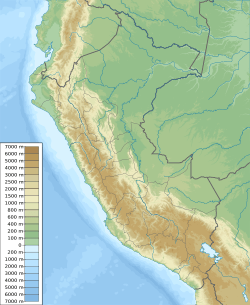Vitcos facts for kids

Vitcos (Rosaspata) archaeological site
|
|
| Alternative name | Rosaspata |
|---|---|
| Location | Cusco Region, Peru |
| Coordinates | 13°05′54″S 72°55′55″W / 13.09833°S 72.93194°W |
| Type | ruins |
| History | |
| Founded | c. 1450 CE |
| Abandoned | 1572 CE |
| Cultures | Inca |
| Site notes | |
| Condition | In ruins |
Vitcos was an important place for Inca nobles and a religious center. It was part of the Neo-Inca State (1537-1572), which was the last part of the Inca Empire that remained free from Spanish control. The old ruins of Vitcos are also known as Rosaspata. You can find them in the Vilcabamba area of La Convención Province, Cusco Region in Peru.
The ruins sit on a high ridge. From here, you can see where two small rivers meet and the village of Pucyura. The Incas first came to the Vilcabamba region around 1450 CE. They built important centers like Machu Picchu, Choquequirao, Vitcos, and Vilcabamba. Vitcos was often where the Inca rulers lived until the Spanish conquered this last Inca stronghold in 1572.
People forgot where Vitcos was for a long time. Then, in 1911, an explorer named Hiram Bingham found the ruins. Local people called them Rosaspata (Quechua: Rusaspata). Bingham realized these were the ancient Vitcos ruins. About 1 kilometer (0.6 miles) south of the main palace at Rosaspata are the ruins of Ñusta Hispana. This was an Inca religious center known as the "White Rock."
The Story of Vitcos
After we arrived at Vitcos, a town about 30 leagues (around 140 km or 87 miles) from Cusco, we who were with my father took a break. We planned to stay and rest for a few days. My father had a house built for himself. The houses already there belonged to my ancestors like Pachacuti Inca, Topa Inca Yupanqui, and Huayna Capac. We had placed their bodies there.
The Vilcabamba region, where Vitcos is located, is very rough and wild. It's on the northeastern side of the Andes mountains and slopes down towards the Amazon Rainforest. This area has snowy mountains, thick forests, jungle lowlands, and rivers flowing through deep canyons. It was very hard to travel here. This made it difficult for the Spanish to destroy the last parts of the Inca Empire.
The Incas had lived in the Vilcabamba region since about 1450 CE. They built major centers at Vitcos, Machu Picchu, Choquequirao, and Vilcabamba. So, the Incas knew this area well. In January 1537, the Inca emperor, Manco Inca Yupanqui, won a battle against the Spanish and their allies at Ollantaytambo.
Even with this victory, Manco Inca was under a lot of pressure from the Spanish. He decided Ollantaytambo was too close to Cusco, which the Spanish controlled. So, he moved west to Vitcos. A Spanish leader named Rodrigo Orgóñez chased him with 300 Spanish soldiers and many Indian allies. In July 1537, Orgóñez took over Vitcos and looted it, capturing many people. But Manco Inca managed to escape.
Manco Inca also survived another Spanish attack in 1539. This time, Gonzalo Pizarro led 300 Spanish soldiers and their allies. The Spanish and Incas fought at Huayna Pukara (Huayna Fort), west of Vitcos. Some Spanish and Indian soldiers died, but Manco escaped again. Pizarro stayed in the area for over two months, trying to find Manco, but he failed. He did capture Manco's main wife. The Spanish wrote that it took "great resources" and "very heavy expenditure" to go into that land.
These two Spanish attacks showed that Vitcos was still reachable by the Spanish. So, Manco developed Vilcabamba as a more hidden and remote safe place. However, for the decades that the Neo-Inca state lasted, Vitcos remained a home for many royal Incas. It was also a place for many religious ceremonies, especially at the nearby shrine of Ñusta Hisp'ana (also called Yurak Rumi or the "White Rock"). The Incas liked living in Vitcos because it was higher up (2,980 meters or 9,777 feet) than Vilcabamba (1,450 meters or 4,757 feet). Vitcos had a cooler climate, which was more like the high mountain home of the Incas.
Spanish attempts to conquer Vilcabamba were also slowed down by fights among the Spanish themselves. A group of seven Spanish rebels, including the person who killed Francisco Pizarro, found safety with Manco Inca. In 1544, they killed Manco Inca in Vitcos. They hoped this would make the Spanish king happy with them again. The Spanish rebels tried to escape, but Manco's guards chased and killed them. The decades after Manco's death were mostly peaceful. The Incas lived in their small remaining empire while the Spanish were busy taking control of other areas.
In 1570, the Spanish and Incas were friendly enough that two Catholic priests were allowed to live in villages near Vitcos. However, these priests caused trouble. They led their followers in an attack that damaged the shrine of Ňusta Hisp'ana. One of the priests was sent away. The other was killed by the Incas. They believed he had poisoned Emperor Titu Cusi Yupanqui, who was Manco Inca's son. Titu Cusi's brother, Tupac Amaru, then became emperor.
Tupac Amaru was much less friendly to the Spanish than Titu Cusi. His supporters killed a messenger sent by the Spanish leader Francisco de Toledo. In response, Toledo ordered an invasion of Vilcabamba. Two armies, with over 300 Spanish soldiers and 2,000 allies (including 500 Cañari people who had long been allies of the Spanish), attacked. In June 1572, the Spanish forces succeeded. They captured Vitcos, Vilcabamba, and Emperor Tupac Amaru. This ended the Neo-Inca state.
Rediscovering Vitcos
For hundreds of years after the Spanish conquest, people forgot where Vitcos was. In his 1911 trip, Hiram Bingham III was looking for Vilcabamba, which was the last capital of the Incas. He followed old descriptions left by Spanish conquerors. This led him to a place local villagers called "Rosaspata." Using the same descriptions, he realized he had found the palace of Vitcos and the sacred site of Ñusta Hisp'ana, also called Chuqip'allta. After quickly mapping both places, he continued his search for the last Inca city. Knowing roughly where Vilcabamba was in relation to Vitcos, he followed what he believed was the correct path. He successfully found and correctly identified both Vitcos and Vilcabamba.
In the 1980s, Vincent Lee explored the Vilcabamba area. He found and described over thirty buildings and structures on the eastern side of the hill between Vitcos and Chuquipalta. These included kalankas (meeting houses), several qollqa (storehouses), and a large usnu (a platform for religious ceremonies). He also found terraces and built-up trails.
The Rosaspata Ruins
Vitcos is located on the northern side of a hill, between the modern villages of Huancacalle and Pucyara. It's the main part of a larger site that covers the whole hill and parts of the valleys to the south and east. South of the hill is Ñusta Hispana, also known as Chuqip'allta and the White Rock. This is a giant carved stone that was believed to be an Inca oracle. There are also terraces along the eastern side of the hill in the valley. These are thought to have been beautiful gardens or ceremonial areas.
The main palace itself has two groups of buildings. The upper group has eight large rooms. These are arranged in four pairs, with two rooms back-to-back. All these rooms are connected by a shared outer wall. This wall has doors that lead to passages between the pairs of rooms. Each room has three doors to the outside of the shared wall, but no doors connecting to the room behind it or to the passages. Each pair of rooms shared a common roof.
North of the upper group is a terrace wall. Below this wall is the lower group of buildings. This group has about a dozen or more buildings arranged around an open courtyard. It's hard to know the exact number of buildings here because they are in much worse condition than the upper group.
Hiram Bingham measured the royal residence. He said it was 245 feet (75 meters) long and 43 feet (13 meters) wide. He noted, "There were no windows, but it was lighted by thirty doorways, fifteen in front and the same in back." He also said, "It contained ten large rooms, besides three hallways running from front to rear." The stone pieces above the doorways (called lintels) were made of solid white granite. Across from the long palace, Bingham measured another building that was 78 feet (24 meters) long and 25 feet (7.6 meters) wide. He described it as having "doors on both sides, no niches, and no evidence of careful workmanship."
Images for kids
See also
 In Spanish: Vitcos para niños
In Spanish: Vitcos para niños





